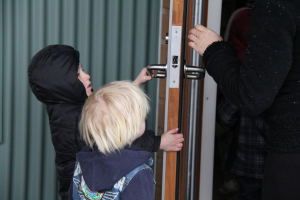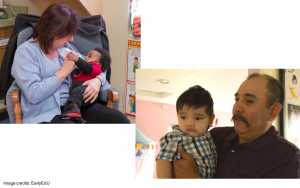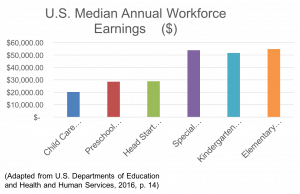14-3 Policy
A – Policies in Early Education

Federal and state governments have a variety of policies that help to provide early learning services to children.
At the federal level, Head Start and Early Head Start serve more than 1 million children annually at a cost of nearly $8 billion. Head Start and Early Head Start provide comprehensive services to low-income children between birth and age five and their families. These programs promote school readiness by supporting children’s early learning, health, and family well-being.
Also, at the federal level, the Child Care and Development Fund (CCDF) provides about 4 million childcare subsidies to low-income working families and serves Head Start and public preschool programs.
At the state and local level, many areas of the country have developed public preschool programs or other public programs that provide early learning services. Particular models and amount of funding vary by location.
Access Challenges

Despite the many programs that offer early learning to low-income children and families around the country, not all low-income children are served by these public programs and not all programs are high-quality.
Families looking for early learning opportunities for their child may encounter several challenges in accessing these programs. We will consider two issues in more depth:
- Are adequate spaces available for children who need services?
- Is high-quality learning equally available for all children in early learning settings?
Regarding adequate slots for children in need of services, consider this: In 2012, more than half of the states were able to serve eligible families who applied for child-care assistance without placing any on waiting lists or freezing intake. However, nearly half of the states had waiting lists or frozen intake for at least some families applying for assistance. Even if families qualify for assistance, there may not be enough slots to give services to everyone who wants them.
As to high-quality early learning, this continues to be a concern for educators in the field. Even when families can access slots, it’s possible that high-quality programs may not be available. Findings suggest that subsidies may enhance care quality, but that parents who use subsidies are not accessing the highest quality care available.
It is important to consider how these factors have an impact on children’s care and development.
Policies That Impact Families

Additional issues, besides the ability to find a high-quality early learning slot for their child, impact families.
Consider parental workplace policies, for example. Not all companies offer parental leave to new parents, and those that do often require parents to use their sick time or vacation time to be home with a new baby. Similarly, not all parents have flexible work schedules, even after parents have returned to work. When children get sick and need to leave their early learning program, who will pick them up? Given everything we have talked about in this course on the importance of children’s earliest years, think about the impact that parental workplace policies have on child development.
Beyond parental workplace policies, we can also think about larger infrastructures that are important to families with young children. For example, is affordable housing widely available? Is public transportation available? If so, is it reliable?
For many new families, these areas of policy are important, even if they are not directly related to children’s development. If you are a low-income family in a large city, it’s important that buses run on schedule so you can make it to the child’s doctor’s appointment on time while missing as little work as possible.
What other policies might affect families with young children? Think about policies that support the family and community around the child.
Policies That Impact Educators

When we think about policies that affect the lives of educators, one of the biggest is salary, and for good reason. A 2016 report on U.S. median annual workforce earnings found that child-care, preschool, and Head Start educators make, on average, $20,000 less per year than their K-12 counterparts.
As we understand more about the importance of children’s early development, many have argued that early learning professionals deserve to be compensated relative to the important work they do, at least on par with teachers in the K-12 system.
As of 2016, only four states required that state preschool programs pay their lead teachers the equivalent of K-12 teachers and only eight states have the same requirement for lead teachers in preschool programs located in public schools.
Recent data indicate that low compensation of early learning educators results in low quality education since the early learning workforce is unable to attract the highest quality workers with low rates of compensation.
Regarding an educator’s ability to provide the highest quality of care to children, it makes sense that educators who earn a living wage provide higher quality environments for children. As we have talked about in this course, low-income families are at risk for experiencing a number of stressors in their life, from food insecurity to working multiple jobs. Educators are not immune to these stressors and it affects the children in their care.

Reflection Point
Many aspects of a child’s life that are out of their control have a significant influence on their development.
Consider these questions in light of the previous information and its influence on child development:
- What influence does state and federal spending on early education have on a child?
- What influence do unemployment and family income have on a child?
B – Case Study
Louisiana School Readiness Tax Credit

One example of a state policy that impacts the lives of educators is the Louisiana School Readiness Tax Credit. Established in 2008, this provides tax credits to families, programs, members of the early childhood workforce, and businesses that support quality early care and education.
Families earn credits by having a child enrolled in a child-care program that participates in the state’s Quality Rating and Improvement System (QRIS), and they receive greater tax benefits as the quality of the program they choose increases.
Child-care programs earn tax credits by increasing their quality score on the QRIS system. Members of the early learning workforce earn tax credits by working in a center enrolled in the QRIS system and their individual tax credit increases as they pursue professional development opportunities or earn higher degrees.
Together, this system is designed to increase the quality of early learning opportunities offered in the state while also providing a financial benefit for those who are working to increase quality.
During the first years of the tax credit, from 2008 to 2011, the number of centers participating in the QRIS system doubled, and the number of centers achieving a quality rating increased from 15 to 50 percent.
Video: The Influence of Policy (17:28)
This TEDx Talk, The Influence of Policy, is by Amy Hanauer, the founding director of Policy Matters Ohio. It is centered on the difference that public policy makes in a community and how the smallest change in policy can make a large difference. Hanauer highlights how individual action can affect larger issues in a community and urges people to discover what they can do to influence policy decisions in their neighborhood.
Watch The Influence of Policy from TEDx Talks on YouTube.

Video Debrief
What difference does public policy make in a community? (click to toggle expand or collapse)
Possible Answers
- Public policy can have an enormous impact on people’s health and well-being.
- Public policy can affect transportation, care for children and people who are elderly, the availability of art, and whether the air and water are clean.
- A small change in public policy can make a large difference in a community.
How can individual action affect larger issues in a community? (click to toggle expand or collapse)
Possible Answers
- Public policy can be hard to change with individual action.
- Usually, a larger group of people is needed to make an impact.
C – Activity
Instructions
Develop an action plan showing ways you can influence policy.
Think of ideas at multiple levels of government:
- What can you do locally, in your neighborhood or city?
- What can you do in your state?
- What can you do at the national level?
 References
References
Barnett, S. W., Carolan, M. E., Fitzgerald, J., & Squires, J. H. (2011). The state of preschool 2011.The National Institute for Early Education Research. [PDF]
Children’s Defense Fund. (2012, January). Fact sheet.
TEDx Talks. (2015, May 15). Amy Hanauer: The influence of policy. [Video]
Ullrich, R., Hamm, K., & Schochet, L. (2017, February 6). 6 Policies to support the early childhood workforce. Center for American Progress. [Online Report]
U.S. Departments of Education and Health and Human Services (2016, June). High-quality early learning settings depend on a high-quality workforce: Low compensation undermines quality. [PDF]
U.S. Department of Health and Human Services, Administration for Children and Families, Office of Head Start. (n.d.). Head Start programs. [Website]
U.S. Department of Health and Human Services, Administration for Children and Families, Office of Child Care. (n.d.). What is the child care and development fund? [Online Resource]
Zero To Three (n.d.). Policy and advocacy. [Website]
EarlyEdU Alliance (Publisher). (2018). 14-3 Policy. In Child Development: Brain Building Course Book. University of Washington. [UW Pressbooks]

